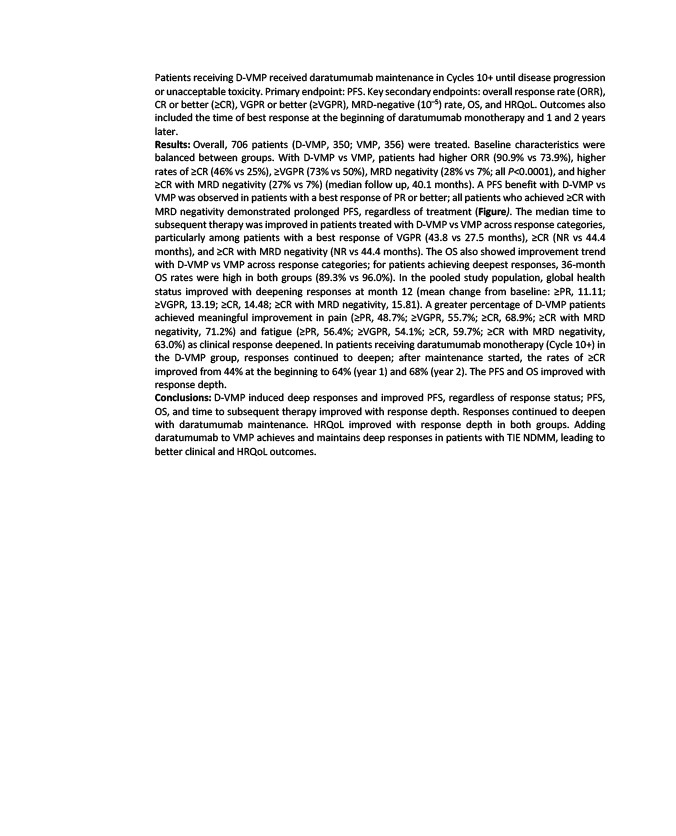
Patients receiving D-VMP received daratumumab maintenance in Cycles 10+ until disease progression
or unacceptable toxicity. Primary endpoint: PFS. Key secondary endpoints: overall response rate (ORR),
CR or better (≥CR), VGPR or better (≥VGPR), MRD-negative (10–5) rate, OS, and HRQoL. Outcomes also
included the time of best response at the beginning of daratumumab monotherapy and 1 and 2 years
later.
Results: Overall, 706 patients (D-VMP, 350; VMP, 356) were treated. Baseline characteristics were
balanced between groups. With D-VMP vs VMP, patients had higher ORR (90.9% vs 73.9%), higher
rates of ≥CR (46% vs 25%), ≥VGPR (73% vs 50%), MRD negativity (28% vs 7%; all P<0.0001), and higher
≥CR with MRD negativity (27% vs 7%) (median follow up, 40.1 months). A PFS benefit with D-VMP vs
VMP was observed in patients with a best response of PR or better; all patients who achieved ≥CR with
MRD negativity demonstrated prolonged PFS, regardless of treatment (Figure). The median time to
subsequent therapy was improved in patients treated with D-VMP vs VMP across response categories,
particularly among patients with a best response of VGPR (43.8 vs 27.5 months), ≥CR (NR vs 44.4
months), and ≥CR with MRD negativity (NR vs 44.4 months). The OS also showed improvement trend
with D-VMP vs VMP across response categories; for patients achieving deepest responses, 36-month
OS rates were high in both groups (89.3% vs 96.0%). In the pooled study population, global health
status improved with deepening responses at month 12 (mean change from baseline: ≥PR, 11.11;
≥VGPR, 13.19; ≥CR, 14.48; ≥CR with MRD negativity, 15.81). A greater percentage of D-VMP patients
achieved meaningful improvement in pain (≥PR, 48.7%; ≥VGPR, 55.7%; ≥CR, 68.9%; ≥CR with MRD
negativity, 71.2%) and fatigue (≥PR, 56.4%; ≥VGPR, 54.1%; ≥CR, 59.7%; ≥CR with MRD negativity,
63.0%) as clinical response deepened. In patients receiving daratumumab monotherapy (Cycle 10+) in
the D-VMP group, responses continued to deepen; after maintenance started, the rates of ≥CR
improved from 44% at the beginning to 64% (year 1) and 68% (year 2). The PFS and OS improved with
response depth.
Conclusions: D-VMP induced deep responses and improved PFS, regardless of response status; PFS,
OS, and time to subsequent therapy improved with response depth. Responses continued to deepen
with daratumumab maintenance. HRQoL improved with response depth in both groups. Adding
daratumumab to VMP achieves and maintains deep responses in patients with TIE NDMM, leading to
better clinical and HRQoL outcomes.